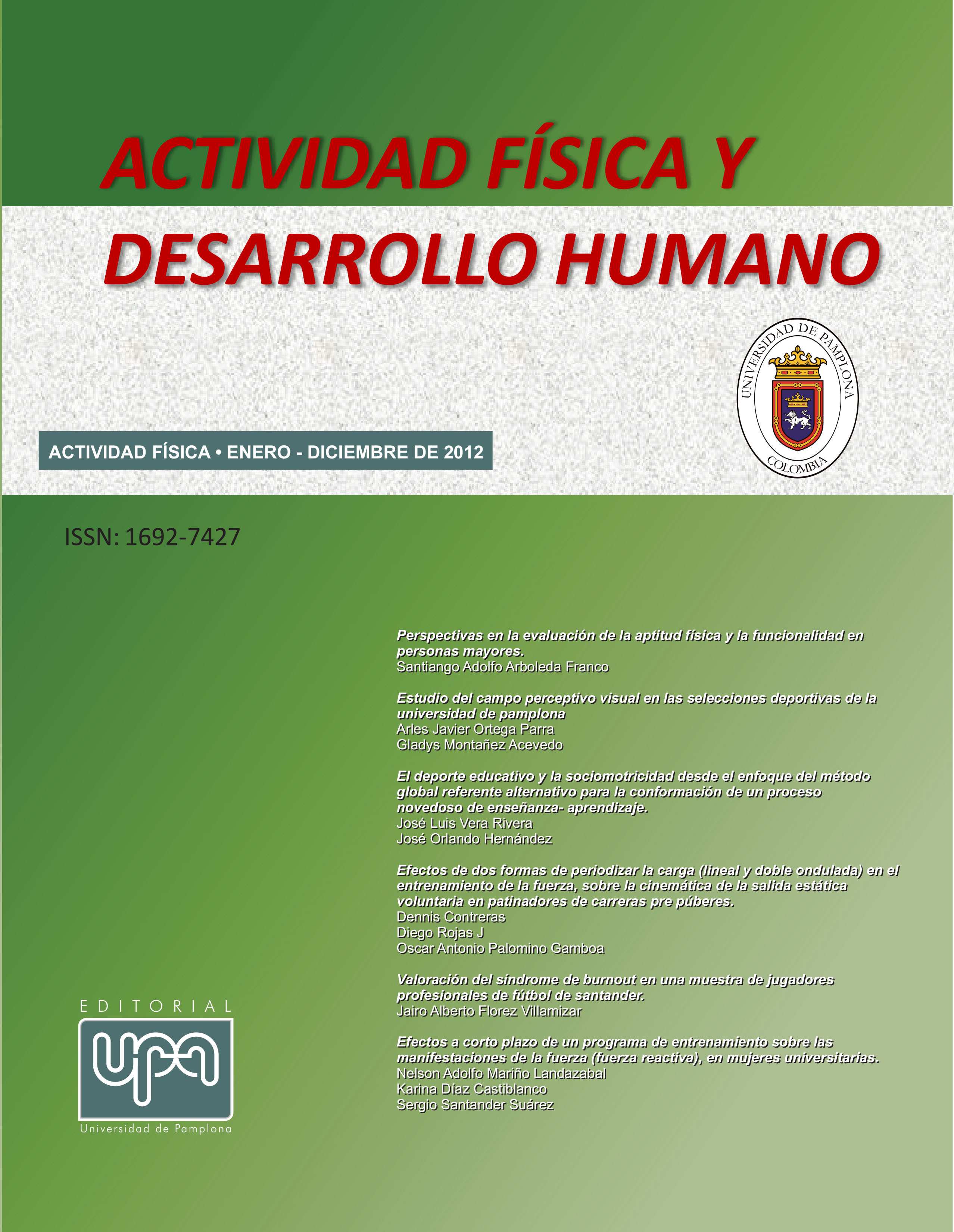La habilidad física percibida y su relación con los niveles de agresividad en jugadores profesionales de fútbol colombiano
DOI:
https://doi.org/10.24054/afdh.v4i1.1709Palabras clave:
Habilidad Física Percibida, conductas agresivas, fútbolResumen
El presente estudio establece la relación existente entre la Habilidad Física Percibida y los niveles de agresividad que tienen los jugadores de fútbol profesional colombiano. La muestra estuvo compuesta por 104 jugadores, pertenecientes a 5 equipos profesio- nales de la primera y segunda división de fútbol profesional colombiano con edades comprendidas entre los 15 y 35 años de edad. Para evaluar los niveles de agresividad se empleó el Cuestionario de Actitudes Antideportivas y Violentas para Deportistas, CAVIDE (Pelegrín et al. 2003) y para valorar la Habilidad Física Percibida, se utilizó la Escala de Habilidad Física Percibida, PPA (Perceived Physical Ability) de Rickman et al. (1982). Se concluye que la batería de cuestionarios utilizada demostró ser un conjunto de instrumentos válido y con un adecuado grado de consistencia interna. Los resultados arrojan que los futbolistas colombianos tienen una percepción de su habilidad física muy buena o excelente, mientras que la agresividad es baja o moderada y siendo las más frecuentes la de tipo verbal y expresiva. Respecto a la correlación de las dos variables objeto de estudio, se concluye que la habilidad física percibida no influye significati- vamente sobre la agresividad de los jugadores y viceversa, lo que quiere decir que las conductas agresivas no influyen sobre la habilidad física percibida en los jugadores de fútbol profesional.
Descargas
Referencias
Algarabel, S., Pitarque, A., & Dasí, C. (2002). Efecto del tipo de información sobre el esfuerzo cognitivo y el estado de consciencia asociado al recuerdo. Psicothema, 14(2), 393–398.
Araya, G., & Salazar, W. (2005). Violencia en el fútbol. Tres estudios sobre la conducta agresiva en situación de competencia y sus implicaciones sociales. Revista Digital, 10(80). Recuperado de http://www.efdeportes.com
Arruza, J., Tellechea, S., Arribas, S., Balagué, G., & Brustad, R. (2005). Capacidad de esfuerzo en snowboarders: Diferencias individuales en una prueba de máximo esfuerzo en halfpipe. Revista de Psicología del Deporte, 14(2), 283–300.
Bakker, F. C., Whiting, H. T. A., & Van de Brug, H. J. H. (1993). Psicología del deporte: Conceptos y aplicaciones. Madrid: Morata.
Bandura, A. (1986). Social foundations of thought and action: A social cognitive theory. Englewood Cliffs, NJ: Prentice Hall.
Berkowitz, L. (1989). Frustration-aggression hypothesis: Examination and reformulation. Psychological Bulletin, 106(1), 59–73.
(Nota: Asumí revista y volumen estándar porque no se especifica. Si tienes datos exactos, los podemos ajustar.)
Borg, G. (1962). Physical performance and perceived exertion. Studia Psychologica et Pedagogica, 11, 1–35.
Dunning, E. (1994). The history of football. En D. Ekblom (Ed.), Football (soccer) (pp. xx–xx). Escocia: Blackwell Scientific Publications.
(Nota: Se recomienda confirmar las páginas exactas y corregir el nombre del editor si fue mal citado.)
Feltz, D. L. (1998). Gender differences in the causal elements of self-efficacy on high-avoidance motor tasks. Journal of Sport and Exercise Psychology, 10, 151–156.
Fernández, J. (1994). Autoestima y locus de control en futbolistas de divisiones inferiores [Tesis de licenciatura no publicada]. Universidad Central de Chile.
Hardy, C. J., & Rejeski, W. J. (1989). Not what, but how one feels: The measurement of affect during exercise. Journal of Sport and Exercise Psychology, 11, 304–317.
Hassmén, P., & Koivula, N. (1996). Ratings of perceived exertion by women with internal or external locus of control. The Journal of General Psychology, 123(4), 297–307.
Iglesias, S., De la Fuente, E., & Martín, I. (2000). Efecto de las estrategias de decisión sobre el esfuerzo cognitivo. Psicothema, 12(2), 267–272.
Miller, M. (1993). Efficacy strength and performance in competitive swimmers of different skill levels. International Journal of Sport Psychology, 24, 284–296.
Parfitt, G., Markland, D., & Holmes, C. (1994). Responses to physical exertion in active males and females. Journal of Sport and Exercise Psychology, 16, 178–186.
Pelegrín, A. (2005). Detección y valoración de la incidencia de las actitudes antideportivas durante la competición. Cuadernos de Psicología del Deporte.
Pelegrín, A., Garcés de Los Fayos, E. J., Jara, P., & Martínez, F. (2003). Estudio de las variables agresivas y violentas en deportistas profesionales: Propuesta para el establecimiento de control de estos comportamientos. Memoria de investigación (N.º de referencia 06/UPB20/02). Madrid: Centro de Alto Rendimiento y de Investigación en Ciencias del Deporte, Consejo Superior de Deportes.
Pender, N. J., Bar-Or, O., Wilk, B., & Mitchell, S. (2002). Self-efficacy and perceived exertion of girls during exercise. Nursing Research, 51(2), 86–91.
Ryckman, R. M., Robbins, M. A., Thornton, B., & Cantrell, P. (1982). Development and validation of a Physical Self-Efficacy Scale. Journal of Personality and Social Psychology, 42, 891–900.
Stephens, D. E., & Shields, D. L. (1997). Construction of a measure designed to assess players’ descriptions of moral behavior in youth sport soccer. International Journal of Sport and Exercise Psychology.
Skinner, J. S., Hutsler, R. E., Bergsteinová, V., & Buskirk, E. R. (1973). The validity and reliability of a rating scale of perceived exertion. Medicine and Science in Sports, 5, 94–96.
Tenenbaum, G. (2001). A social-cognitive perspective on perceived exertion and exertion tolerance. En R. Singer, H. A. Hausenblas, & C. Janelle (Eds.), Handbook of sport psychology (pp. 810–820). New York: John Wiley & Sons.
Descargas
Publicado
Número
Sección
Licencia
Derechos de autor 2012 ACTIVIDAD FÍSICA Y DESARROLLO HUMANO

Esta obra está bajo una licencia internacional Creative Commons Atribución-NoComercial-SinDerivadas 4.0.











